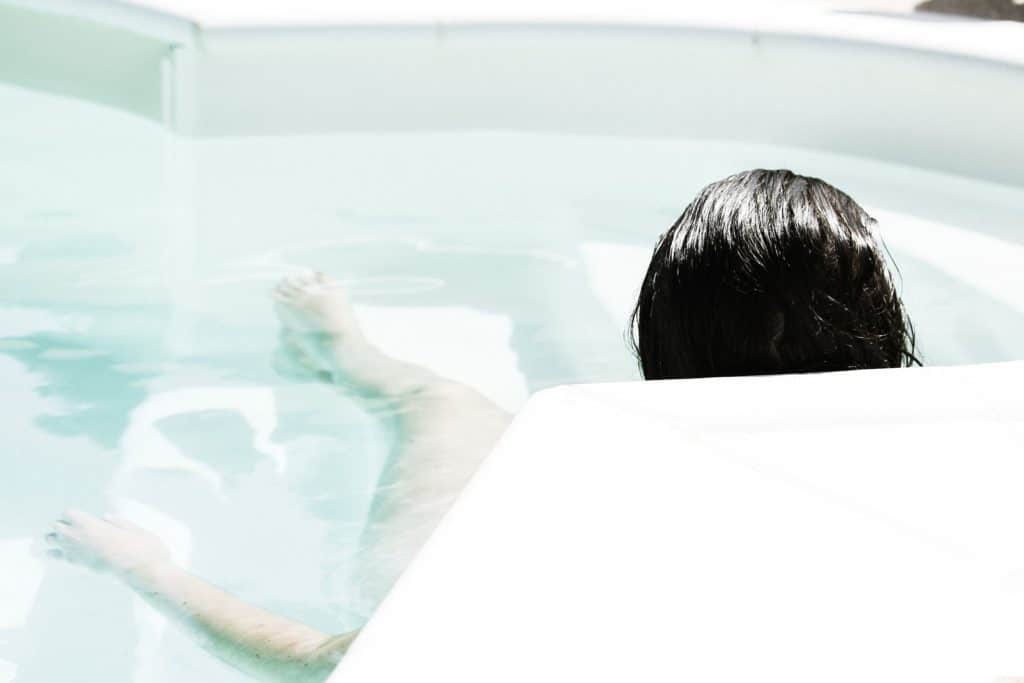What is baking soda? it’s sodium bicarbonate. and what is sodium bicarbonate? it is an alkaline compound used as one of the treatments for kidney stones along with other drugs.
Why is it used for that purpose? because most kidney stones, like calcium oxalate and uric acid kidney stones, usually form under an acidic environment in the urinary tract (the urinary tract includes: the kidneys, the ureters, and the urethra… etc).
So baking soda which is an alkaline (basic) compound can neutralize the acidity of the urinary tract, thereby easing the process of dissolving and getting these stones out with the urine.
A preferred environmental condition for UTI causing bacteria like the E. coli, which is the bacteria responsible for more than 80% of UTI cases around the world, is to live in a urine pH of about 6 to 7.5, and that means these bacteria prefer to live in slightly acidic or alkaline medium, in other words, It prefers a near-neutral pH environment.
Normal urine PH is also the slightly acidic pH of about 6.
With UTIs indeed urine pH sometimes gets more acidic than usual because of the bacteria, but neutralizing this acidity with the alkaline baking soda isn’t going to help UTI patients because as we said earlier this is the preferred pH for UTI bacteria to grow.
Not all the time does the urine become acidic when there is a urinary tract infection happening. in the majority of cases, urine pH varies slightly or doesn’t vary at all, so again introducing that alkaline baking soda through baths is going to disrupt your urinary tract’s normal pH environment, especially if it’s used frequently or in high concentrations.

Bacterial action in the urinary tract might make the urine pH sometimes shift towards acidity depending on the circumstances. for example, if the environment contained high amounts of sugar and other substances. See this reference.
But, this high acidity achieved in some experiments, in fact, halted bacterial growth and that was the case with E. coli bacteria.
But you should not aim to lower or increase the acidity or alkalinity of the urine in the case of UTI. This is not how a UTI is treated. Antibiotics are the treatment for UTI and when they succeed in eliminating the bacteria, your urine pH will get back to normal if it was changed at all.
In some experiments, baking soda raised the pH of the medium making it highly alkaline thereby inhibiting the growth of some bacterial and fungal colonies but doing so in the human body and the urinary tract, in particular, can cause more problems than it can solve.
And in the same studies, it was shown that it was impossible for baking soda to produce that effect without the need to raise its concentration to the point where it becomes intoxicating for the organism.
Many would promote the idea of using baking soda in the treatment of UTIs basing on such experiments, but that is completely wrong and harmful for communities.
That “neutralizing effect” of baking soda isn’t going to “cure” urinary tract infections or even improve them by any margin.
Drinking baking soda can actually mask symptoms of UTI. and putting it in the bathwater can also expose patients to that risk because indeed the baking soda can reach the urinary tract.
It was found that when putting sodium bicarbonate (baking soda) in bathwater the baking soda will reach the urethra, moreover, in extreme cases baking soda climbed up the urethra reaching the urinary bladder and that can constitute a lot of risks to these parts of the urinary tract.
The only legitimate medical use for baking soda in the case of UTI is as a UTI pain killer.
Indeed drinking baking soda by UTI patients can soothe the symptoms of UTI, and although it is not stated by the BNF, so can having a bath with baking soda. But, in the long run, it can mask the symptoms of UTI and eventually make it worse. review the BNF, 68th edition, page 555.
Baking soda or urine alkalinization, in general, should not be used as treatments for UTI. the only approved use for them in the case of UTI is for UTI pain relief. using them incorrectly or without medical supervision can result in the exacerbation of the existing UTI condition.
The best way to use baking soda for UTI people is by using it for pain relief from UTI symptoms for a short amount of time only, 2-3 days maximum, once or twice a day, 15 _ 30 minutes, and then patients should refrain from using it any further.
This will ensure the UTI pain is soothed to some extent while the antibiotics begin to work. Consult your doctor if you feel your symptoms are not improving after that period.
Bacteria cannot withstand highly acidic or highly alkaline environments, so if the baking soda succeeds in alkalinizing any part of the urinary tract or making it more than slightly alkaline, there is a good chance that the UTI progress will be halted to some extent, but there is even a bigger chance that other even more serious problems will emerge.
In fact, there are many cases of people visiting the emergency departments of hospitals because of baking soda misuse, but usually, that comes from drinking baking soda although dissolving it in bathwater can carry some risks.
The main point is: do not use baking soda in any shape or form to treat UTI.
Some bacteria, E. coli and other UTI bacteria included, excrete acids as they grow which increases the acidity of the medium. This is why many UTI patients experience more than normal acidic urine in the course of the infection. highly acidic urine is also not good for anyone and it’s distressing for the patients.
This can be combated with drinking a lot of water on a daily basis, which not only will neutralize the acidity of urine, it will also wash out the bacteria from the urinary tract in addition it will have many other detrimental effects on UTI bacteria.
Sitting in a baking soda bath every once in a while is not that big of a deal. it can provide some pain relief against the UTI, but soaking yourself in it several times a day is where we’ll have a problem.
According to the BNF, the dose for the oral dosage form of baking soda should be 3g-reconstituted in a glass of water-3 times daily, with the avoidance of prolonged use and for pain relief only as we said, however, there is no literature on baking soda baths because they are not yet approved by the FDA (food drug administration) or the NHS to be used even for pain relief against UTIs.
Note: The FDA and the NHS are the authority on these matters in the world.
However, there is no serious harm from using baking soda baths for normal, healthy individuals as we have specified earlier.
Baking soda is used to treat other conditions, like metabolic acidosis and others, but we mentioned kidney stones at the beginning of the article because it’s relevant to the topic.
Baking soda baths can have that calming and soothing effect, so if you enjoy them you can have them but as specified in the article.
Baking soda can interact with UTI medications
Baking soda in the oral form interacts with a lot of antibiotics that can be used in the treatment of UTI like Ciprofloxacin, Cefuroxim, levofloxacin, Doxycycline, Azithromycin and others mainly through inhibiting their absorption from the stomach, rendering them inactive. But with the case of baking soda baths, there will be no such interactions.
Adverse effects of baking soda are also mainly caused by oral consumption. Baking soda baths will be safe if used as specified earlier in the article.
People with dermatological disorders, infections or wounds or anything wrong with their skin should consult their doctor before taking a baking soda bath, especially if they have cracks in their skin that water can enter through, also this bath should not be used for children. More about this in this reference.

The BNF. Edition 68. Page 555.
Now is sitz bath good for the uti?
First, a sitz bath requires that the person sits in the water in a sitting position with the water reaches up to his or her hips, now if you just use water in this bath that is O.K. and it has proven to be beneficial to relieving various UTI symptoms.
But, some people prefer to add other ingredients, so depending on the ingredient or ingredients added sitz bath can be sometimes good and sometimes bad.
For more information on sitz baths and their effects on UTI, please visit our sitz bath for UTI article.
Some people add baking soda to it.
In that case, they should use it in the same way that we described for regular baths. only for UTI pain relief and for a limited time and the concentration of the baking soda should be adjusted also.
Some people put Epsom salts in Sitz bath water.
Epsom salts are magnesium salts, mostly it’s magnesium sulfate salt, originally magnesium sulfate is used in a lot of other medical uses other than treating UTI, for example, it’s used as a laxative to treat constipation
Also, I have found that it’s used as a remedy for some wounds that are caused by boiling water and other types of wounds.
This means that it has some antibacterial activity, but it’s not like the antibacterial activity that antibiotics have. I think it’s because of its acidic nature and we know that acidity kills bacteria.
Whatever is the reason behind magnesium’s ability to impede bacterial growth, in the end, we know that it does fight bacteria.
So the answer is yes, by putting Epsom salts ( magnesium sulfate salts) in your sitz bath water or even in your regular bath water (in the bathtub) you can ease some of the discomfort and irritation associated with the UTI as well as making the process of recovery faster and easier.
But don’t count on it as your primary treatment for UTI and don’t replace going to the doctor with these solutions.
What else do people put in their sitz bath?
People also put apple cider vinegar in their sitz bath or regular bathwater.
Well, the main constituent of apple cider vinegar is acetic acid. acetic acid is known to be a bacteriostatic agent. which means that it has the ability to stop the growth of the bacteria, It also can stop the growth of fungus infections.
So, apple cider vinegar has been used in many medical applications like treating ear infections, adding it to foods will prevent the growth of harmful bacteria and fungi on the food.
So putting apple cider vinegar in your sitz bath water or in your regular bath water will help in the treatment of the UTI but be careful not to put high amounts of it in the bathwater.
Just one cup of it in the whole bathwater is sufficient, as for the sitz bath water the quantity is lower than that maybe 1/4 a cup, depending on the quantity of water that will be in the bath.
Ps: be careful not to put high amounts of apple cider vinegar in the bathwater because putting more than enough amounts of it may cause irritation, burning to the skin, and other harmful side effects, sometimes blisters on the skin appear only after a while from using it.
And do not take too much time sitting in the water 10 to 15 minutes may be enough.
Apple cider vinegar is an excellent preventative measure against UTI, however, in treating UTI you need to consult your doctor before using it although I don’t think that there is any problem in using it along with the other treatments of UTI.
But, that’s only if you keep it in your bathwater, not if you take it by mouth.
If you drink apple cider vinegar by mouth
Be sure to dilute it to an acceptable level before drinking it or adding it with food, put one tablespoon of apple cider vinegar in one litre of water before drinking it, or before adding it to food like salads or so.
As I said apple cider vinegar is an excellent precautionary measure against UTI weather if you put it in your sitz bath or put it in your salad. but do not use it as your primary treatment against the UTI if you already have a uti contact the doctor as soon as possible so that the infection doesn’t spread and get worse.
Some websites say that when apple cider vinegar enters the body it turns into an alkaline (basic) compound, so that it may not be good for UTI because as we know highly alkaline compounds are not good for UTI.
Well, I say that is completely not true because an acidic compound remains an acidic compound whether it enters or leaves the body, that is a known chemistry principle. It could interact with the body making it more acidic or less alkaline though.
Also, other websites falsely suggest that apple cider vinegar is already an alkaline compound and say that it can make the urine less acidic and that drinking apple cider vinegar on a regular basis can decrease the chance of you getting a kidney stone!!
Well, they are unfortunately gravely mistaken too. Apple cider vinegar can’t be used as a treatment nor as a preventative measure for kidney stones.
Ps: basic compounds are good for kidney stones but apple cider vinegar is not basic it’s acidic because the main component in it is “acetic acid”.
If you dilute it with a lot of water or use it with salad then that water or salad can contribute to improving kidney stones symptoms.
What else can we put in our bathtubs to ease the uti?
We can put white vinegar, although it’s less acidic than apple cider vinegar, white cider vinegar is also used as a food preservative and also have anti-bacterial, anti-yeast activity, so putting it in your bathtub is not a bad idea although it requires lesser dilution than apple cider vinegar.
Some people also put balsamic vinegar in their baths
This vinegar is used with foods in Italy to give it a taste, there is no evidence that it can work on the UTI so I prefer that you use the other kinds of vinegar that I mentioned but there is no harm from using that is if you know the right dilution method for it with water.
In general, vinegar baths whether if you put it in a sitz bath or in a regular bath can be beneficial the UTI patients but do not use them as a replacement for visiting the doctor these baths may not be sufficient to cure the UTI all on their own, and antibiotics may be necessary for you to eradicate the bacteria that caused your UTI completely.
Essential oils baths have also been used
While there are many types of essential oils and they are very diverse, some of these oils have proven to have antimicrobial activity and this is very encouraging, however, some of them are known to have a toxic effect with prolonged contact with the skin.
Also, most of these oils may require not to be diluted with water to have their full effect otherwise they may not show a significant effect on UTI or on other conditions so by putting them in the bath you will dilute them with a lot of water making them inactive or less active.
With less dilution, there may come the problems of toxicity to the sensitive skin of the genitalia which is not good at all for UTI sufferers.
Essential oils do not have a lot of scientific evidence to back their use with UTI and they have side effects, therefore you should not use them unless under medical supervision.
Generally speaking, using these different kinds of baths and delaying your visit to the doctor may have a negative effect on your UTI because at that time the bacteria can spread to other parts of the urinary tract like the kidneys or so and cause a much bigger problem.
So it’s best to use sitz baths and the regular bath as a support for the original treatments given by your doctor and use them in the right way as I have taught you.
If you follow the instructions from this article carefully you will be able to benefit from your sitz bath or regular bath with no problems.
Sitz baths can be a very good way to relieve some of the UTI pain and aid in the treatment if you use them wisely.
SOOTHIC over the toilet Sitz bath is very suitable for UTI patients.
